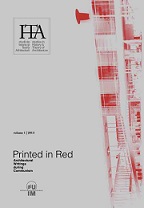Testing the Physiognomy of the Arhitectura Magazine (1952-1989)
Testing the Physiognomy of the Arhitectura Magazine (1952-1989)
Author(s): Ana Maria ZahariadeSubject(s): Architecture
Published by: Universitatea de Arhitectură şi Urbanism »Ion Mincu«
Keywords: the Arhitectura magazine; ideology; political and professional thematic; editorial compass
Summary/Abstract: On the effervescent but unsteady scene of architectural publications before the Second World War, the 36 issues of the Arhitectura magazine of the Society of Architects were, from 1906 until 1944, a benchmark of stability and consistency, in spite of the many interruptions and delays. Its follower, ARHITECTURA RPR (renamed ARHITECTURA) is (re)born in 1952, after the communist regime was installed, by governmental decree, as "organ" of the Union of Architects. From 1953 until December 1989, issued without interruption, it would be the only architectural periodical extensively spread, due to its state funding. Dedicated to architectural design, edited by the Union of Architects and written especially by architects, the new series has minutely and ceaselessly recorded the achievements of the period and the life of the profession. As such, it constitutes the main documentary source for deciphering the professional history during Communism; it has been widely used in recent researches. Yet, being the only publicly spread and easily accessible architectural periodical of communist Romania, ARHITECTURA was more than a passive witness, a mirror of history; we can presume that it was, in its own way, a "creator of history", an active participant in the professional history. This hypothesis brings into discussion the editorial policy of the magazine, its internal life, of which we know very little, still. Even though the magazine was financially supported by the state, the editors had to face rather unusual conditions, where professional and political missions met. While the archives of the Union of Architects are still closed and the editorial staff is no longer alive, the only resource on this matter is the magazine itself. The article surveys the “surface” of the magazine, hypothesizing that this epidermal layer was a sensitive interface between the “voice” of the profession on one hand and the eye of censorship, on the other. The dynamics of this interface was modeled specifically by absorbing the never won but never lost game between the political authority – on which the mere existence of the magazine depended – and the architects’ expectations – to which the magazine responded with its professional identity. In the given circumstances, always politically determined, their meeting was initially conducted on the readily visible field that precedes the written discourse, before going in the deeper substance of the texts. This is why the article avoids discussing the content of the articles, except for the editorials; the same reason goes for the authors present in the issues.
Journal: sITA – studii de Istoria şi Teoria Arhitecturii
- Issue Year: 2013
- Issue No: 1
- Page Range: 161-183
- Page Count: 23
- Language: English

